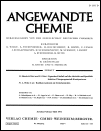Ionic Hydrogenations and Dehydrogenations†
Dedicated in friendship to Prof. Dr. Otto Bayer on the occasion of his 60th birthday.
Abstract
In acetonitrile, 4-chlorobenzenediazonium fluoroborates readily add onto trimethylamine to give 4-trimethylammoniumbenzenediazonium chloride fluroborates. These addition products have a pronounced tendency to accept two hydrogen atoms in the form of a hydride ion and a proton from donors such as 1,4-dihydrobenzene, 1,3-dioxolans, 1,4-dioxan etc. The diazonium group is thereby reduced, and the trimethylammonium group is split off as trimethylammonium fluroborate and replaced by the chloride ion. In the presence of a trace of copper, the reaction mechanism is changed from an ioinic to a free-radieal one. In this case, just as in the absence of copper, the diazonium group is reduced, but the trimethylammonium group is retained. Alcohols behave in the same way as the donors of ionic hydrogen cited.




